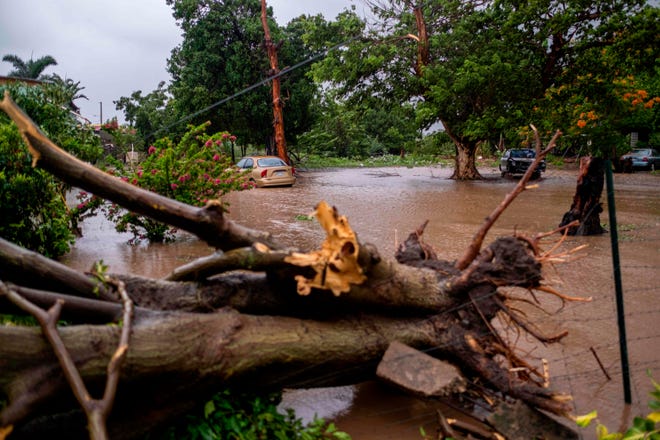
As Tropical Storms Marco and Laura barrel toward Louisiana, you may wonder how well your homeowners or renters insurance will hold up in a natural disaster.
The answer largely depends on the disaster. Damage from many calamities are covered by a standard policy, but a handful are not and require separate coverage for protection.
Even if your insurance covers the peril, it may not be enough. Many homeowners and renters don’t have adequate protection to cover all their losses. And, because of a change in the tax law, uninsured losses can only be deducted in specific cases.
Here’s what you need to know about your insurance covering your house or apartment. Cars are another matter, but we’ll get to that, too.
What damage does insurance cover?
Homeowners, condo and renters insurance cover damage sustained from most perils, including tornado, hurricanes, severe storms, rain, wind and fires. Homeowners insurance will pay to repair the structure of the property up to the insured amount and other detached structures like a garage or garden shed – typically around 10% of the main structure’s insured amount.
It also covers possessions inside the home – typically up to 50% to 70% of what the structure of your home is insured for. Landscaping elements such as trees and shrubs are generally reimbursed at about $500 per item, says Loretta Worters, a vice president at the Insurance Information Institute.
Condo insurance covers possessions and some structural elements, such as drywall in the unit. The condo association’s insurance should cover damage to the building. Renter’s insurance only covers your possessions – often excluding appliances – but your landlord should have a policy that covers the structural elements of the apartment.
What damage is not covered?
Damage from flooding and earth movement – which includes earthquakes, mudslides, landslides and sinkholes– is excluded from homeowners, condo and renters insurance.
To get flood protection, you must buy a separate policy from the federally funded National Flood Insurance Program or a private insurer. You must also buy separate coverage for your possessions; these are not automatically included in the flood policy, says Don Griffin, vice president of personal lines at the American Property Casualty Insurance Association.
For earthquakes, you must buy a separate policy from a private insurer or, if you live in California, from the state’s California Earthquake Authority. In some states, insurers will cover sinkholes if you buy separate coverage.
Some policies may also exclude specific weather in certain areas where it’s common – such as windstorms for coastal states.
“In coastal states like Texas, Florida and Louisiana, they have what they call coastal programs,” Griffin says. “What it does is if windstorm is excluded in the policy, you can buy it back through the state’s program.”
Any other coverage?
A homeowners, condo or renters policy will reimburse you for any additional living expenses you incur because you can’t live in your damaged home: costs like hotels, restaurant meals and laundromat expenses.
“The coverage pays only for expenses you wouldn’t normally have,” Worters says. “It also has either a percentage of your dwelling coverage limit or a time limit, so check your policy to see what type of coverage you have.”
Any theft or damage done to your home by looters or vandals after a disaster is also covered by your homeowners, condo or renters policy.
What about uncovered losses?
You can deduct personal property losses not covered by your insurance, but only if the damage is from a federally declared disaster. This is a significant change under the new tax reform law. Before, any unreimbursed casualty or theft losses could be deducted.
To deduct the losses, you must subtract $100 from each loss before adding them up. The total must be more than 10% of your adjusted gross income.
Homeowners and renters can also apply for a low-interest, long-term federal loan from the Small Business Association to help pay for losses from a declared disaster. You can borrow up to $200,000 to repair or replace your primary home along with up to $40,000 to replace possessions.
Insurance preparation
Your insurer can cover only what it knows you lost. That’s why it’s important to keep accurate records for filing claims in the future.
Make sure your insurance policy accurately describes your home – including square footage, number of rooms, age and materials it’s constructed from. It should also account for any recent improvements – like a new roof or water heater – and upgrades – such as a room addition or new pool.
It’s also important to have an inventory of your possessions. It can be hard to remember what you owned in the emotional aftermath of a disaster, especially if you and your family are dealing with injuries or worse.
An easy way to take inventory ahead of time is to go through each room and closet and record every possession on your smartphone’s video. When possible, note the make and model of items, especially higher-end appliances.
Rare or expensive items such as art, collectibles or jewelry require additional coverage apart from your homeowners, condo or renter’s insurance, and must get appraised first before getting a separate policy.
Store your inventory record and insurer’s contact info somewhere besides your house or digitally where you can retrieve it at any time.
What about your car?
If your auto insurance policy includes comprehensive coverage – which is not required by law – then your insurer will pay for costs to repair damage to your car from any peril, such as major weather events or simply a fallen branch. Unlike homeowners insurance, your auto policy typically covers flood and earth movement.
Your auto insurance often will cover rental car fees while your car is repaired or replaced. In some cases, it’s not automatically included, so you have to purchase this coverage at an extra cost.











